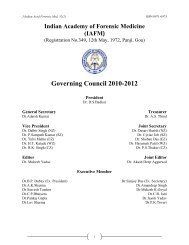Download - forensic medicine
Download - forensic medicine
Download - forensic medicine
Create successful ePaper yourself
Turn your PDF publications into a flip-book with our unique Google optimized e-Paper software.
JIAFM, 2007 - 29(4); ISSN: 0971-0973<br />
Discussion:<br />
Establishment of identity is one of the objectives of<br />
medico-legal autopsy.[1, 2, 3] Relatives and friends<br />
of deceased person usually establish identity in<br />
recently dead person. But in India, considering the<br />
climatic condition, the decomposition progresses<br />
rapidly, which hampers the establishment of identity.<br />
As the interval between death and examination of<br />
body progresses, efficacy of establishment of<br />
identity by ordinary scientific means such as<br />
photographs and fingerprints decreases.<br />
Establishment of identity is difficult not only in highly<br />
decomposed bodies but also in charred bodies,<br />
mutilated bodies and fragmentary remains. In such<br />
cases the help of other means such as x-ray<br />
examination of body is sought to establish<br />
identity.[1, 2, 3] Jablonski NG et al.[4] in his study<br />
reported two cases in which positive identification of<br />
unknown human remains were achieved by<br />
comparison of radiographs. Lichtenstein JE et al. [5]<br />
discussed role of radiology in identification of<br />
casualty victims by comparison with ante mortem<br />
films and records. Fitzpatrick JJ [6] carried out a<br />
study of 100 identifications with the help of<br />
radiographs. Brogdon BG [7] discussed scope of<br />
<strong>forensic</strong> radiology including determination of identity.<br />
Schmidt G et al.[8] studied use of radiographs in<br />
<strong>forensic</strong> autopsy and reviewed various modes of<br />
their application including identification of corpse<br />
from bone. Bratzke H et al [9] studied 427<br />
radiographic examinations during the course of<br />
medico-legal autopsies & discussed various uses of<br />
radiology including identification of person.<br />
References:<br />
1. Modi’s Textbook of Medical Jurisprudence & Toxicology. 22 nd<br />
edition, 2001, Edited by B. V. Subrahmanyam, Published by<br />
Butterworth India, New Delhi, PP 78-79 & 111.<br />
2. Parikh C. K. Parikh’s Textbook of Medical Jurisprudence,<br />
Forensic Medicine and Toxicology. 6 th edition 2004,<br />
Published by CBS Publishers & Distributors, New Delhi, PP<br />
2.35, 2.71, 2.76.<br />
3. Reddy K. S. Narayan. The Essential of Forensic Medicine &<br />
Toxicology. 22 nd Edition, 2003, Published by K. Suguna Devi,<br />
Hydrabad, PP 73, 102, 104.<br />
4. Jobolnski NG, Shum BS. Identification of unknown human<br />
remains by comparison of antemortem and postmortem<br />
radiographs. Forensic Sci Int. 1989 Aug; 42(3):221-30.<br />
5. Lichtenstein JE, Madewell JE. Role of radiology in the<br />
study and identification of casualty victims. Radiologe, 1982<br />
Aug; 22(8): 352-7.<br />
6. Fitzpatrick JJ. Role of radiology in human right abuse. Am J<br />
Forensic Med Pathol. 1984 Dec; 5(4): 321-5.<br />
7. Brogdon BG. The scope of <strong>forensic</strong> radiology. Clin Lab<br />
Med. 1998 Jun; 18(2): 203- 40.<br />
8. Schmidt G. Kallieris D. Use of radiograph in the <strong>forensic</strong><br />
autopsy. Forensic Sci Int. 1982 May-Jun; 19(3): 263-70.<br />
9. Bratzke H, Schneider V, Dietz W. Radiographic<br />
investigation during medico-legal autopsies. Rofo.1982Apr;<br />
136(4): 463-72.<br />
Post Mortem radiograph of right thigh of the deceased showing metallic rod in femur<br />
93




![syllabus in forensic medicine for m.b.b.s. students in india [pdf]](https://img.yumpu.com/48405011/1/190x245/syllabus-in-forensic-medicine-for-mbbs-students-in-india-pdf.jpg?quality=85)



![SPOTTING IN FORENSIC MEDICINE [pdf]](https://img.yumpu.com/45856557/1/190x245/spotting-in-forensic-medicine-pdf.jpg?quality=85)

![JAFM-33-2, April-June, 2011 [PDF] - forensic medicine](https://img.yumpu.com/43461356/1/190x245/jafm-33-2-april-june-2011-pdf-forensic-medicine.jpg?quality=85)



![JIAFM-33-4, October-December, 2011 [PDF] - forensic medicine](https://img.yumpu.com/31013278/1/190x245/jiafm-33-4-october-december-2011-pdf-forensic-medicine.jpg?quality=85)

